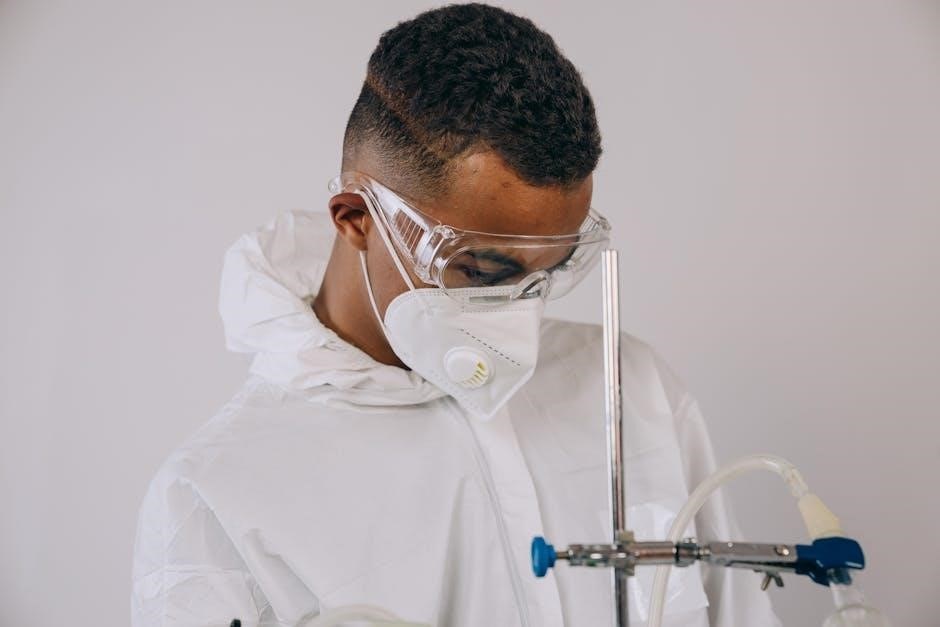Biological anthropology explores human diversity and evolution through scientific study. This laboratory manual provides a structured approach to engaging with key concepts, fostering hands-on learning and critical thinking skills.
1.1. Definition and Scope of Biological Anthropology
Biological anthropology examines the biological and genetic aspects of humans, focusing on evolution, genetics, and diversity. It integrates laboratory and fieldwork to study human variation, osteology, and forensic applications. This subfield explores how humans adapt to environments and how evolutionary processes shape our species. The laboratory manual provides practical exercises to analyze skeletal remains, measure anatomical traits, and apply forensic techniques, bridging theory with hands-on experience. By combining scientific methods with real-world applications, biological anthropology offers insights into human origins and contemporary populations, making it a cornerstone of interdisciplinary research in anthropology. This workbook enhances understanding through experimental learning, fostering critical thinking and analytical skills essential for the field.
1.2. Key Concepts and Subfields in Biological Anthropology
Biological anthropology encompasses several key subfields, including genetics, evolution, human osteology, and forensic anthropology. Genetics explores hereditary traits and evolutionary processes, while osteology focuses on the study of human skeletons. Forensic anthropology applies these concepts to legal contexts, aiding in identifying remains. Additionally, the field investigates human adaptation to environments, such as climate and diet, and examines the fossil record to understand human origins. This manual provides exercises to analyze genetic data, measure skeletal traits, and apply forensic techniques, offering a comprehensive understanding of the discipline. By integrating these subfields, biological anthropology provides a holistic view of human biology and evolution, equipping students with diverse analytical skills.
Laboratory Manual and Workbook Structure
This manual is organized into chapters, each focusing on specific biological anthropology topics, with structured exercises and practical applications to enhance learning and skill development.
2.1. Organization and Design of the Manual
The manual is structured to guide students through biological anthropology systematically. Chapters are logically arranged, starting with foundational concepts and progressing to advanced topics. Each section includes clear learning objectives, relevant background information, and step-by-step instructions for lab exercises. Visual aids, such as diagrams and tables, enhance comprehension. The design emphasizes practical application, with exercises mirroring real-world scenarios in biological anthropology. Supplementary materials, like glossaries and reference charts, are integrated for easy access. This user-friendly layout ensures that students can navigate the content efficiently, fostering a deep understanding of both theoretical and practical aspects of the field.
2.2. Workbook Exercises and Practical Applications
The workbook exercises are designed to reinforce theoretical concepts through hands-on activities. Each exercise includes clear instructions, expected outcomes, and space for recording observations. Topics range from genetic analysis to osteological measurements, ensuring a comprehensive understanding. Practical applications, such as case studies and data interpretation, encourage critical thinking. Students are guided to conduct literature searches and analyze datasets, fostering research skills. Interactive activities, like reconstructing evolutionary timelines, enhance engagement. The exercises are aligned with learning objectives, ensuring students develop proficiency in biological anthropology methods. By applying knowledge in real-world contexts, students prepare for advanced studies and fieldwork, bridging theory and practice effectively.

Core Topics in Biological Anthropology
Biological anthropology examines human genetics, evolution, and osteology, offering insights into human diversity and adaptation. These topics bridge science and humanities, shaping our understanding of human biology and behavior.
3.1. Genetics and Evolution in Biological Anthropology
Genetics and evolution form the cornerstone of biological anthropology, exploring how genetic variation shapes human diversity. Laboratory exercises focus on analyzing genetic data, tracing evolutionary processes, and understanding adaptations. Practical activities include studying mitochondrial DNA, Y-chromosome variation, and genomic sequencing to reconstruct evolutionary histories. These exercises integrate theoretical concepts with hands-on methods, enabling students to grasp how genetic changes influence human traits over time; By examining fossil records and modern populations, students gain insights into the mechanisms driving human evolution. This section emphasizes the role of genetics in understanding human origins, migration patterns, and adaptation to diverse environments, providing a comprehensive framework for analyzing evolutionary processes.
3.2. Human Osteology and Forensic Anthropology
Human osteology and forensic anthropology are vital components of biological anthropology, focusing on the study of human skeletons and their application in legal and investigative contexts. Laboratory exercises emphasize the identification and analysis of skeletal remains, including age determination, sex estimation, and trauma assessment. Students learn to apply osteological techniques to reconstruct biological profiles and solve forensic cases. Practical activities involve examining bone morphology, identifying pathologies, and applying forensic methods to real-world scenarios. This section bridges academic theory with professional practice, preparing students to contribute to fields such as crime scene investigation and bioarchaeology. Hands-on training enhances understanding of human skeletal variation and its forensic implications.
Research Methods in Biological Anthropology
Biological anthropology employs diverse research methods, including data collection, analysis techniques, and ethical considerations. These approaches are applied in laboratory settings to explore human variation and evolution.
4.1. Data Collection and Analysis Techniques
Biological anthropology employs various data collection methods, including morphometric analysis, genetic sampling, and osteological examinations. These techniques allow researchers to gather precise measurements and biological samples. In the laboratory, students learn to apply statistical software for data analysis, interpreting results to understand human variation and evolution. Practical exercises often involve measuring skeletal remains, analyzing DNA sequences, and conducting comparative studies. Ethical considerations ensure responsible handling of biological materials. This hands-on approach bridges theoretical knowledge with practical skills, preparing students for advanced research in biological anthropology. The integration of modern technologies enhances accuracy and efficiency in data processing, making these techniques essential for both educational and professional settings.
4.2. Ethical Considerations in Biological Anthropology Research
Ethical considerations are paramount in biological anthropology research, ensuring respect for human and non-human subjects. Researchers must obtain informed consent, protect privacy, and avoid harm. Cultural sensitivity is critical when studying diverse populations. The handling of biological samples, such as skeletal remains, requires adherence to legal and ethical guidelines. Collaboration with communities ensures research is conducted responsibly and benefits local populations. Ethical training is integral to laboratory work, promoting accountability and transparency. These principles uphold the integrity of biological anthropology, fostering trust between researchers and the communities they study. Adherence to ethical standards is essential for advancing knowledge while respecting human dignity and cultural heritage.

Laboratory Exercises and Activities
Hands-on exercises in biological anthropology labs involve osteology, genetics, and forensic analysis, fostering critical thinking and practical skills through interactive learning experiences and real-world case studies.
5.1. Measuring and Analyzing Human Skeletons
Measuring and analyzing human skeletons is a cornerstone of biological anthropology. This involves osteometric analysis, using tools like calipers and osteometers to record precise measurements of cranial and postcranial elements. Such data helps determine age, sex, ancestry, and stature. Students learn to identify skeletal landmarks and apply standardized protocols to ensure accuracy. Practical exercises often include calculating indices, such as the cranial index, to explore human variation. Additionally, analyzing skeletal pathologies and trauma provides insights into an individual’s life history. These hands-on activities are complemented by case studies, reinforcing the connection between theoretical concepts and real-world applications. This section emphasizes the importance of meticulous documentation and ethical handling of skeletal remains in laboratory settings.
5.2. Case Studies in Biological Anthropology
Case studies are essential for applying theoretical knowledge to real-world scenarios in biological anthropology. They provide hands-on experience in analyzing skeletal remains, identifying pathologies, and reconstructing life histories. Through detailed examinations, students learn to interpret osteometric data, assess trauma, and determine ancestry. Practical exercises involve applying ethical guidelines to ensure respectful handling of remains. These studies also highlight the importance of accurate documentation and data interpretation. By engaging with case studies, learners develop critical thinking and problem-solving skills, preparing them for professional research and fieldwork. This section bridges theory and practice, offering practical insights into the complexities of human biology and evolution.

Resources and References
This section provides essential readings, online tools, and advanced search strategies to support comprehensive learning and research in biological anthropology.
6.1. Essential Readings and Bibliography
This section compiles key textbooks and scholarly articles foundational to biological anthropology. Works like Bernard’s Anthropology and the Social Sciences and O’Leary’s The Foundations of Social Research are highlighted. Review papers and introductory chapters provide entry points for deeper exploration. Bibliographies guide students through seminal studies, ensuring a robust understanding of evolutionary principles and anthropological methods. These resources bridge theoretical concepts with practical applications, offering a comprehensive foundation for laboratory and fieldwork. By referencing these materials, learners gain access to critical insights and methodologies that underpin the discipline.
6.2. Online Tools and Digital Resources for Biological Anthropology
Online platforms like Google Scholar and JSTOR provide access to seminal articles and research papers in biological anthropology. Digital databases, such as those from university libraries, offer extensive collections of e-books and journals. Interactive tools, including 3D modeling software and virtual laboratory simulations, enable students to explore anatomical structures and conduct analyses remotely. Websites like the National Center for Biotechnology Information (NCBI) and the Human Genome Project offer valuable resources for genetic studies. Additionally, online forums and study groups connect learners with experts and peers, fostering collaborative learning and professional development. These digital resources enhance the learning experience, making complex concepts accessible and engaging for students of biological anthropology.

Biological anthropology’s integration of theory and lab work drives innovation. Emerging technologies and interdisciplinary approaches promise to expand our understanding of human evolution and diversity in exciting ways.
7.1. The Importance of Laboratory Work in Biological Anthropology
Laboratory work is essential for applying theoretical knowledge in biological anthropology. It provides hands-on experience with methods like osteology, genetics, and forensic analysis, fostering critical thinking and practical skills. Through lab exercises, students engage directly with biological specimens, data collection tools, and advanced technologies, enhancing their understanding of human evolution and diversity. Laboratories also encourage collaborative problem-solving and scientific inquiry, preparing students for real-world research and professional applications. By integrating lab work with theoretical concepts, biological anthropology laboratories bridge the gap between classroom learning and fieldwork, ensuring a comprehensive education in this dynamic and interdisciplinary field.
7.2. Emerging Trends and Innovations in the Field
Biological anthropology is evolving rapidly, with advancements in genetic sequencing, ancient DNA analysis, and 3D scanning technologies. These innovations enable deeper insights into human evolution, migration patterns, and population dynamics. Virtual reality and digital tools are transforming laboratory work, allowing for immersive and interactive learning experiences. Collaborative research and interdisciplinary approaches are fostering new discoveries, while ethical considerations ensure responsible use of emerging technologies. These trends highlight the field’s commitment to innovation and its potential to address complex questions about humanity’s past, present, and future. By embracing these advancements, biological anthropology continues to advance our understanding of human diversity and evolution.
